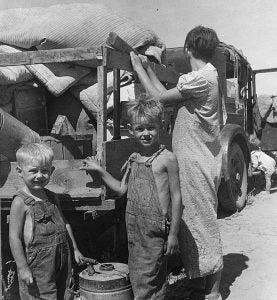Could the Dust Bowl Ever Happen Again
The American Dust Bowl of the 1930s — captured by the novels of John Steinbeck — was an environmental and socio-economic disaster that worsened the Smashing Depression.
The Grit Bowl was an extreme upshot. But due to climate change, massive crop failures are more probable to happen once again in the future. New research in Frontiers in Sustainable Food Systems aimed to answer what these impacts may look similar.
The Grit Bowl was centered on the Corking Plains of the U.South., where decades of unsustainable deep plowing had displaced native, wet-retaining grasses. An atypical La Niña so brought intense droughts, high temperatures, and strong winds which blew abroad the topsoil in the course of large-scale dust storms.
Apart from its directly bear upon on people (effectually 7,000 deaths and ii million homeless), the Dust Bowl had a catastrophic event on crops where wheat and maize production in the U.Due south. plummeted by 36 pct and 48 pct during the 1930s.
Currently, the Intergovernmental Panel on Climate Change predicts that in another three to four decades that virtually of the U.Southward. will have further warmed by 1.5 to 2 degrees C. This compounds issues that already be today, where global food security is under pressure from the increased frequency of extreme weather condition events.
"We wanted to forecast how a multi-year production turn down in a major exporting land, similar to that which occurred during the Dust Basin, would affect modern nutrient supplies globally via international merchandise," says get-go writer Dr Alison Heslin, a postdoctoral researcher at the Eye for Climate Systems Enquiry of Columbia Academy and NASA's Goddard Found for Space Studies.
"In today's system of global food trade, disruptions are non spring by borders. Shocks to production are expected to impact trade partners who depend on imports for their domestic nutrient supply."
To appraise the possible impacts of a 2d Dust Basin, the authors first adult two alternative computer simulations of the worldwide trade in wheat. They then delivered a shock to these model systems in the class of a iv-year-long Dust Bowl-like anomaly, restricted to the U.South.
Under 1 simulation, countries first use their reserves and and then divide the absorbed daze between imports and exports, propagating it in ane direction past increasing imports and in another by decreasing exports.
Under the more complicated second model, the U.S. first reduces simply its exports, propagating the shock to all receiving trade partners, after which all countries with a shortage respond past increasing their imports.

Their results predict a severity similar to that of the original upshot, estimated from historical data. The results testify that the U.South. would fully exhaust 94 percent of its reserves over the showtime four years of a Dust Bowl-liked agricultural shock.
They also show that without exception, all countries to which the U.S. exports wheat would decrease their reserves, fifty-fifty though they didn't themselves suffer crop failure.
"We focused on a subset of the possible impacts, specifically changes in merchandise, drawing downward strategic reserves and decreases in consumption," says co-author Dr Jessica Gephart, Assistant Professor at the Section of Environmental Scientific discipline of the American University in Washington DC.
"We found that global wheat merchandise contracts and shifts toward other wheat exporters, and that wheat reserves around the world refuse, in many cases to zero. This suggests that the impacts would not merely raise prices for United states consumers but would also raise prices far beyond the United states borders," says Gephart.
Central impacts of another iv-year dust bowl could include an initial 31 percent loss of global wheat stocks, and by the end of the 4 years, between 36 and 52 countries could have used up over 75 percent of their starting reserves. The ten countries with the highest initial reserves (Mainland china, U.S., India, Iran, Canada, Russia, Morocco, Australia, Egypt, Algeria) would come across their reserves decline by xv to 22 percent relative to the starting points.
Yet, a silver lining is that due to the high initial starting signal of global reserves, virtually supply shocks, even in countries without reserves, could be addressed through trade flow adjustments without reducing consumption.
Sponsored Content on AGDaily
Source: https://www.agdaily.com/insights/impact-second-dust-bowl-look-like/
0 Response to "Could the Dust Bowl Ever Happen Again"
Post a Comment